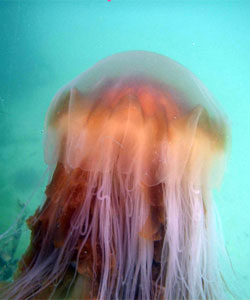Jellyfish Stings
Background
- Most jellyfish in Irish waters are non-toxic. Recently - Portuguese Man-of War appeared
- Venom stored in nematocysts (cellular capsules called) on tentacles
- Nematocysts fire tiny harpoon with thread of venom
- Nematocysts fire even after jellyfish dead (on a beach)
- Lions Mane is (or Man-of-War) the most venomous jellyfish in Irish waters:
- Mostly northern Irish sea
- Up to 80cm in diameter
- Toxin may be very painful
Management of sting
- Protect yourself
- Remove the victim from the water
- Remove any attached tentacles with a gloved hand, stick or towel
- Do NOT rub the affected area (releases more venom)
- Rinse the affected area with vinegar (or sea water - not fresh water)
- Apply heat (water or a heat pack) max 45°c
- Xylocaine spray (4% or 2.5%) eases symptoms and reduced further toxin release from nemocysts
- Do not use other washes (urine, alcohol) as these can worsen toxin release
- All with airway, constitutional or eye symptoms should attend an emergency department
- Detailed slit lamp exam is required in eye injuries
- Later relief may be gained from hot water (denatures remaining venom)
Content by Dr Íomhar O' Sullivan. Last review Dr ÍOS 31/05/23.
